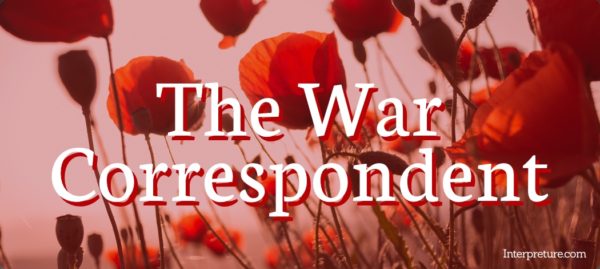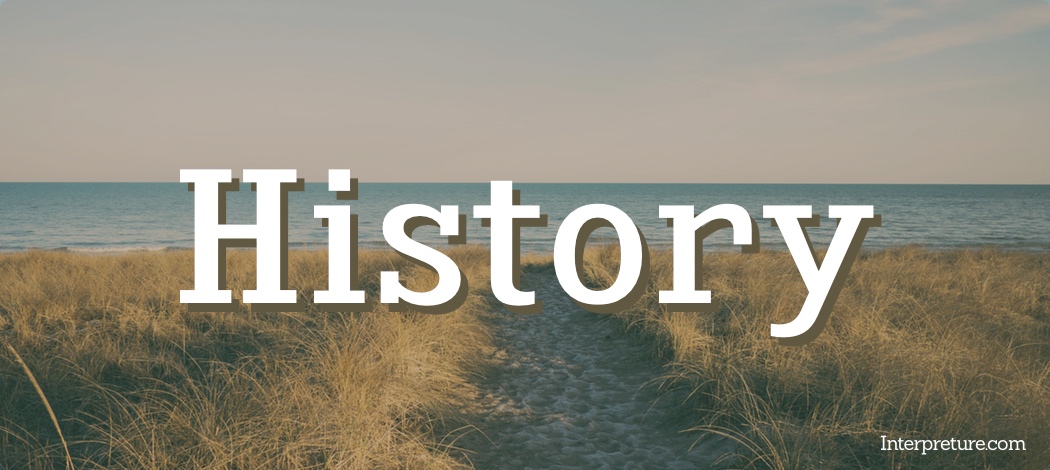‘The War Correspondent’ is a series of poems by Ciaran Carson which is based on the Crimean War, split into seven individual poems; two of which, Gallipoli and Balaklava, are included within the Poems of the Decade anthology. Carson was born in Belfast in 1948 and has lived there for much of his life, including through The Troubles. This setting has often been influential in his work, including the acclaimed ‘Belfast Confetti’ which is frequently part of many GCSE courses. In an interview with The Guardian, Carson described how he is “interested in words” and “how words connect with experience” and both of these factors can be seen as a key aspect of his work.
This poem is no longer part of the set of prescribed poems that could be included in the Edexcel English Literature exam, however it is still useful for practice as an unseen poem. Click here to see a full list of revision notes for the examined poems.

Interpreture gives ‘The War Correspondent’ a difficulty rating of 4, meaning that it is deemed to be a relatively difficult poem. This poem is somewhat unusual amongst others from the ‘Poems of the Decade’ anthology as while the themes are easy to identify, this doesn’t correspond to the meaning due to the multiple layers of meaning and importance of contextual awareness. In addition, the language and structure may be difficult for students to fully appreciate and understand, resulting in this poem being difficult in a number of ways. Similarly, ‘The War Correspondent’ actually being a series of poems could confuse some students.
‘The War Correspondent’
The title of the poem is relatively informative, indicating that it will directly look at warfare, whether that be the factual aspects of a war or the effect it has on ordinary people and citizens. As a ‘correspondent’ a reader would be encouraged to see the poem as presenting some form of factual information, drawing on real life events so as to inform a modern reader of a specific point in time. In this anthology “Gallipoli” and “Balaklava” are chosen (poems one and four from the series), and as such the reader would correctly assume that these locations are the subject matter of the poems. It would also be clear that these are foreign places, and some readers may also recognise them as key locations in the Crimean War.
It is important to note that in the initial release of the Edexcel Teacher Guide (a key source of ‘Poems of the Decade’ notes for many teachers) discussed how the “Gallipoli” poem was about the First World War. However, Ciaran Carson has since clarified that “Gallipoli” and “Balaklava” are both about the Crimean War.

Poem Structure
An important consideration in ‘The War Correspondent’ is how the structure changes between the two separate poems that are included, specifically the way that the rhythm adjusts. A reader would not necessarily expect there to be any consistency as while part of the same set of poems, they are still different, and in addition the two included in this anthology are the first and fourth in the set. The contrast that is therefore shown by placing them together could be seen as effectively demonstrating the differences and transitions within war, and how their ‘feeling’ and nature can change relatively quickly.
However, the stanza form is still difficult to feel within each poem, which could be seen to heighten a reader’s feeling of insecurity and emphasise the unknown element of war. For example, “Gallipoli” does not have any immediate sense of a specific rhythm within the first stanza, and there is a lack of rhyme. Then in the second stanza, a feeling of rhyme becomes clearer as an ABCDE ABCDE pattern between the two stanzas is established. Rhyming and half rhymes are then used in the rest of the stanzas, however there are seemingly random changes and breaks on specific lines, with a new rhyme sound started. This stop-start feeling could be interpreted as a representation of the ever changing nature of war. The same kind of technique is also used in “Balaklava” with similar rhyme breaks or repetitions of words in order to continue the rhyme.
While the rhyme scheme and individual words may have lots of variation, the actual stanza structure is very uniform and repetitive in both poems. In “Gallipoli” there are ten lots of five line stanzas, meanwhile in “Balaklva” there are four stanza of eight lines, so while the latter is actually a shorter poem, this may not initially be the impression that a reader has due to the relatively long and dense stanzas. The regularity to the two structures could also be interpreted by a reader as the regularity of war and the inevitable cycles within it, perhaps evoking a feeling of being overwhelmed by the continual nature of war and destruction shown through this structure.
Poetic Techniques
A notable element of “Gallipoli” is how various stanzas open with instructions to the reader, such as “take” for the first four stanzas, and then “dress” and “requisition” later in the poem. These imperative order words would be noticeable due to their sharp sound, particularly “take” with the ‘t’ plosive sound, which gives the impression that they are being shouted, which would be very effective if the poem were to be read aloud. In addition, they can be interpreted as making a reader feel as if they are complicit with the events being described, which may create more empathy to the regular people and scenes being described.
Another interesting technique used in ‘The War Correspondent’ in the progressive de-familiarisation in the locations and scenes being described in each stanza. This is seen through the subtle shift from descriptions of “Turks” to “an English horseman” in “Balaklava” but this technique is more noticeable in “Gallipoli” with transitions from “Billingsgate” (a famous fish market in central London) in the first stanza, to “Irish landlord” in the second stanza, and then listing various countries with “Cupriot and Turk, Armenians and Arabs” in the fifth stanza. Even more obscure places which are unlikely to be recognised by British readers are also described as the poem goes on, before ending on the line “I have not even begun to describe Gallipoli” which very effectively shows the varied culture and combination of people in this location. Some readers may appreciate the focus on the human side of conflict, whereas others may find it interesting that an event from so long ago could still be so multicultural and effect so many different people.
Links to significant contextual points help to aid memorability of the poem and increase the links to the Crimean War, helping to make the poem feel more realistic and as such more emotive for a reader. For example, “Balaklava” has direct links to the infamous Charge of the Light Brigade through the line “the slain of October 25th” as this was the date of the famous battle which went disastrously wrong, ending in huge losses for the British. This is made even more emotive for a reader through the description “skeleton of an English horseman” as this more personal link to British society helps to create additional empathy.
Important Lines
“plus interpreters who do not know the lingo”
This line is interesting because it combines the connotations of distance and the unknown with “interpreters” with the more personal and informal term “lingo” which highlights the disruptive nature of war, and how people travel to new places as part of a conflict that they would not have usually fitted into, and arguably still don’t.
“I have not even begun to describe Gallipoli.”
The final line for “Gallipoli” is very effective because it demonstrates to a reader the huge and wide raging implications of war on a country and region, and how so much of everyday life and culture is swept up into the chaos and disruption it brings. It also makes the reader curious to know more about “Gallipoli” and what is happening there, creating a deeper connection which effectively makes them more interested in the poem.
“Tangled with rotted trappings”
The alliteration of the plosive ‘t’ would effectively make this phrase noticeable, particularly when read aloud as some readers may interpret this sound to be like drums that are part of military parades, further emphasising the militarily link. The description “rotted trappings” is also interesting in how it concentrates on the outside description through vivid imagery, which may be interpreted by some as Carson showing that physical disruption from war can be seen, but the mental side effects can’t be seen and are often not appreciated.
‘The War Correspondent’ Key Themes
- Conflict: By being directly about war and the implications that it has for societies and individuals, this poem clearly relates to the theme of conflict. However, it is important to remember that it is more than just conflict through war, but also contrasts between cultures, individuals, professions and living conditions.
- Past and Present: The focus of descriptions in ‘The War Correspondent’ is on the past, which encourages a reader to consider the relation of the past to the present day and how those previous events may have had an impact, and also if there are any lessons that could be applied to the world today.
- Society and Culture: Many different peoples, nationalities and cultural differences are highlighted (particularly in “Gallipoli” but also to a lesser extent in “Balaklava”) which helps to show war as being something with the potential to encompass wide ranging swathes of humanity. Some may also interpret the poem as showing how war and conflict have become ingrained within our culture.
Quick Focus Questions
- How is the splitting of ‘The War Correspondent’ series into separate poems effective on a reader?
- How does effective imagery impact a reader response? Pick one example in “Gallipoli” and one in “Balaklava”.
- Does a reader need to have knowledge of the context of ‘The War Correspondent’ in order for it to be effective? Make sure to justify your answer by including analysis.
‘The War Correspondent’ can be a daunting poem to consider, although there are many interesting points that can be made for both structure and language. In addition, while context can be helpful to take into consideration, it isn’t required as part of your analysis in the exam (for the A Level Edexcel course) as the focus is instead on making perceptive points based on analysis. As such, this could be a good option to pick, or a great way to practice a more difficult poem in a practice essay. Some poems that could be good for comparison are ‘Giuseppe’ or ‘The Gun’ with their links to conflict or a focus on the different structures and their link to the past in ‘The Fox in the National Museum of Wales’ or ‘The Map Woman’.







2 Comments
Could I have your citation for Carson’s explanation of Gallipoli being set in the Crimean War. Loads of sources and analyses say it is World War One. Is there an interview with him where he says this specifically? It would help me to be more secure in teaching the context of it. Thanks.
Edexcel released this PDF document (source page) in 2016 regarding the setting and interpretation of the poem but frustratingly they never actually provided a proper source or explanation.
‘The War Correspondent’ is part of Carson’s collection ‘Breaking News’ which, from what I have read, is based on the work of William Howard Russell who wrote about The Crimean war for The Times (and died before World War I even started). Unfortunately I haven’t had access to a copy of this collection in order to provide further clarification.
I suspect this confusion caused by the exam board contributed to their decision to remove it from the main A Level specification. Hope this helps!